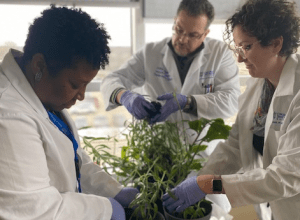
Pharmacy student Nuchi Thao wants to know more about Mother of Thousands medicinal uses.
Mother of Thousands medicinal uses
Thao, a third-year Concordia School of Pharmacy (P3) student, is studying her grandmother’s household plant—but it’s not just any houseplant. Bryophyllum Daigremontianum, known as Mother of Thousands, has been used as a natural product remedy in her Hmong culture for years. Mother of Thousands is suspected to have medicinal properties. Thao became interested in studying the plant through pharmacy, and it’s led to some favorable preliminary endorsements.
Cultural Ties and Traditional Knowledge
In many cultures, the Mother of Thousands is involved in various medicinal usages, including wound-healing, anti-cancer, and anti-inflammatory treatments. In the Hmong culture, people commonly use the Mother of Thousands for coughs. Thao has known of this traditional knowledge, and just recently had an opportunity to further study the plant through pharmacy. Through a student-led research project, Thao studied her grandmother’s household plant, Bryophyllum Daigremontianum (Mother of Thousands) in a pharmacy setting.

Thao was inspired to research this topic through Concordia’s pharmacy elective course titled “Medicinal Natural Products.” The course is taught by Dr. Uvidelio Castillo, Christopher W. Cunningham, and Terry-Elinor Reid. It gives pharmacy students the opportunity to study plants, particularly ones that traditional cultures have already identified as medicinal, in a pharmacy setting. One of the aims of the course is to introduce Pharmacognosy. Secondly, the instructors hope to inspire the need for more natural product research and support.
Thao was interested in studying a plant with personal ties.
“While I previously never understood the chemistry behind this medicinal usage for coughs, the elective course gave me the chance to not only conduct experiments on the plant and learn about extraction techniques, but also helped deepen the connection between my culture and the pharmacy field,” Thao said.
Research Opportunity
During the class, Thao worked on phytochemical extraction that led to interesting preliminary antimicrobial results. These results indicated possible support for the plant usage in coughs and wound-healing. Furthermore, Thao decided to continue to explore the research results to show the potential medicinal benefits of the plant. Through her continued research, Thao hopes to confirm these results with further experiments.
“I hope to further investigate these medicinal properties in order to spread my findings to both the pharmacy world and the Hmong community,” Thao said.
In addition, she’d like to continue to explore other possible medicinal properties, such as anti-cancer usage.
Inter-Collaborative Support
 Concordia’s School of Pharmacy inter-collaborative approach led to the addition of another faculty member, Dr. Tzvia Springer, to the research team. This also meant incorporating the participation of undergraduate student Madison Chapman. This inter-collaborative approach fosters interaction between pharmacy and undergraduate students. Also, it encourages teamwork and cultivates independent thinking by students while getting them excited about scientific research. Concordia’s faculty wants to encourage student participation in research at all stages of their education. It’s their goal.
Concordia’s School of Pharmacy inter-collaborative approach led to the addition of another faculty member, Dr. Tzvia Springer, to the research team. This also meant incorporating the participation of undergraduate student Madison Chapman. This inter-collaborative approach fosters interaction between pharmacy and undergraduate students. Also, it encourages teamwork and cultivates independent thinking by students while getting them excited about scientific research. Concordia’s faculty wants to encourage student participation in research at all stages of their education. It’s their goal.
“We always enjoy seeing the student’s excitement when they work on scientific projects,” Dr. Tzvia Springer said.
Pictured above are pharmaceutical science research faculty Dr. Terry-Elinor Reid (left), Dr. Uvidellio Castillo (center), Dr. Tzvia Springer (right) transplanting Bryophyllum Daigremontianum (Mother of Thousands) plants for research purposes.
To learn more about the School of Pharmacy, visit www.cuw.edu/pharmacy.
—
If this story has inspired you, why not explore how you can help further Concordia's mission through giving.